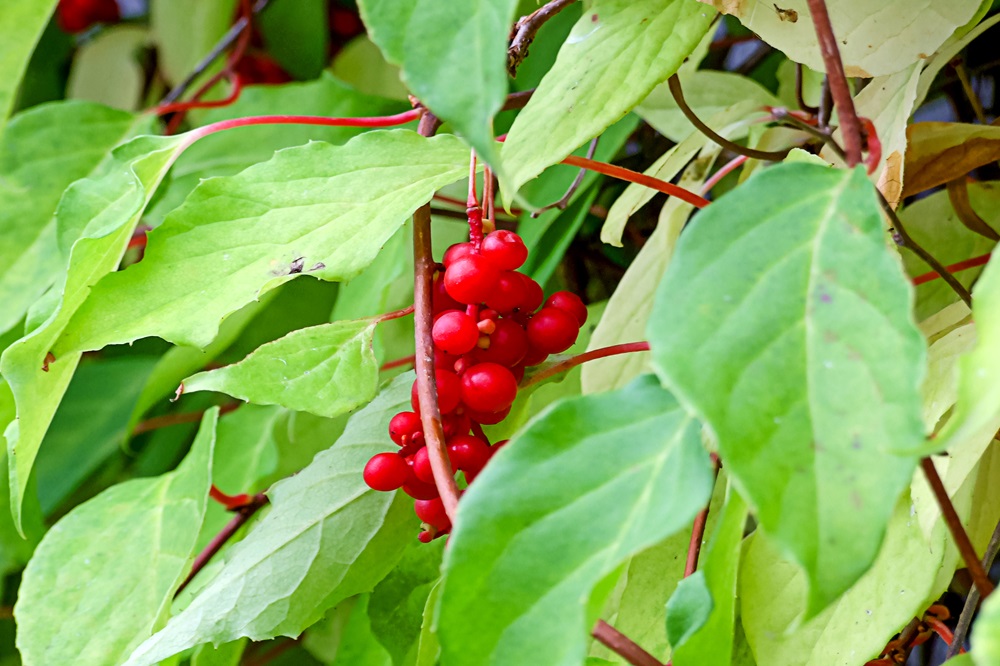Chinese Schisandra – Effects, Uses, and Possible Side Effects of This Adaptogen

Chinese magnolia vine is an Asian plant rich in valuable compounds, gaining growing popularity among consumers worldwide. This climbing plant has a wide range of uses - it is grown in horticulture, used in cosmetics, cooking, and as an ingredient in dietary supplements. It may help strengthen immunity, support the nervous system, and promote healthy liver function. Chinese magnolia vine can also help reduce fatigue and lower oxidative stress. What properties does this plant have? Is Chinese magnolia vine worth using for weight loss? How can you consume it? Is it worth choosing dietary supplements containing Schisandra chinensis extract?
Table of contents
Chinese magnolia vine - what is it?
Chinese magnolia vine (Schisandra chinensis) is a species from the Schisandraceae family, naturally found in the northeastern regions of China, as well as in Japan, Korea, and eastern Russia. It grows on the edges of mixed forests and near bodies of water. In Asia and Europe, it can also be found in gardens and urban green spaces, where it is cultivated as an ornamental plant.
It is a dioecious climbing plant that prefers warm, sheltered spots protected from wind and fertile soils. It is frost-resistant but does not tolerate drought. In favorable conditions, Schisandra chinensis can grow up to 15 meters tall. Its flexible stems wrap around tree trunks and can reach about 1.5 cm in diameter. The decorative leaves are elliptical or obovate, with prominent veins and pointed tips. Interestingly, when torn, the leaves release a pleasant lemon scent. The fragrant flowers grow on long stalks from leaf axils and are white or pinkish-white. The fruits ripen in late August or early September and are juicy, red berries with a lemon aroma, forming clusters of 10–40 berries.
In Asian countries, Chinese magnolia vine is called Wu Wei Zi – the plant of five flavors. The berries are said to contain sour, sweet, salty, bitter, and astringent tastes. In ancient China, almost all parts of the plant were used, including leaves, shoot tips, and bark, but today the most commonly used part is the fruit with seeds.
Chinese magnolia vine - nutrients
Schisandra chinensis is packed with valuable compounds – over 200 beneficial substances have been identified. The plant contains, among others:
- vitamin C
- B vitamins
- vitamin E
- organic acids such as citric acid and malic acid
- essential oils
- flavonoids
- phenolic acids
- minerals such as potassium, phosphorus, and magnesium
- polysaccharides
- lignans, including schizandrin
Thanks to this rich composition, the plant has been known and used in Asia for thousands of years.
Chinese magnolia vine - properties
Chinese magnolia vine is an adaptogenic plant that may help the body adapt to stress. It can also act as an antioxidant, neutralizing free radicals and reactive oxygen species, reducing oxidative stress, and slowing cell aging.
Due to its valuable lignans, Chinese magnolia vine may have a positive effect on the nervous system, protecting nerve cells and increasing neurotransmitter levels. It may also improve cognitive functions such as reflexes, focus, learning, and memory.
The compounds in this vine may also have hepatoprotective effects, supporting regeneration and protection of liver cells. Extracts of Schisandra chinensis may help lower blood glucose and triglycerides, support digestion, improve pancreatic function, and stimulate insulin secretion – showing potential anti-diabetic properties. Additionally, it may have anti-inflammatory effects, help reduce high blood pressure, and protect cardiovascular health.
Current data also suggest antibacterial and antiviral potential. Animal studies indicate that Schisandra chinensis may aid in weight loss. It appears that its compounds can reduce lipid content, promote lipolysis, and decrease the size of subcutaneous fat cells, which may help lower body fat levels and support weight reduction, particularly in overweight or obese individuals.
Furthermore, Chinese magnolia vine may help relieve menopausal symptoms such as hot flashes, palpitations, and excessive sweating. Its high vitamin C content supports immune system function, reducing susceptibility to infections. It may also benefit the respiratory system by easing persistent cough and shortness of breath.
Chinese magnolia vine - uses. How to consume it?
Chinese magnolia vine is mainly used as an herbal raw material and as an ingredient in dietary supplements. Products typically contain fruit extract, often standardized for lignan content, especially schizandrins. It is available in tablet, powder, or capsule form. Some supplements contain only Schisandra chinensis, while others combine it with other adaptogens such as astragalus, rhodiola, or gotu kola – the choice depends on individual needs and preferences.
The vine can also be cultivated as an ornamental plant. Its fruits can be made into jams and preserves, perfect for cakes, pancakes, or tea, and can also be used for juices, tinctures, wine, or infusions.
Due to its toning, moisturizing, and blood vessel-constricting properties, Schisandra chinensis is increasingly used in cosmetics, especially in cleansing, anti-aging, and soothing skin care products.
Chinese magnolia vine - side effects
Chinese magnolia vine and its extracts are generally well tolerated and considered safe. However, excessive intake may cause side effects such as indigestion, nausea, vomiting, heartburn, abdominal pain, or allergic skin reactions.
It should not be consumed in the evening before bedtime, as it may stimulate the body and make falling asleep difficult.
Chinese magnolia vine - contraindications
Chinese magnolia vine should not be used by people with nervous hyperactivity or high blood pressure. It is also not recommended for those with insomnia, heart rhythm disorders, or epilepsy.
Caution is advised for people taking medications or other supplements, as Schisandra chinensis may interact with certain drugs, including barbiturates.

